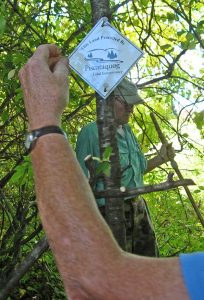 Picture yourself in the woods on a PLC-protected property. You stop to write in a notebook: "beavers have moved in and begun damming up this brook. When you look at the photos taken in this spot last year, there's no sign of beaver activity. And over there is a patch of trailing arbutus that’s worth noting.”
Picture yourself in the woods on a PLC-protected property. You stop to write in a notebook: "beavers have moved in and begun damming up this brook. When you look at the photos taken in this spot last year, there's no sign of beaver activity. And over there is a patch of trailing arbutus that’s worth noting.”
Have you ever wondered what Easement Monitors do? They literally put boots on the ground for PLC, the primo part and 'parcel' of land protection. Every property protected by the Piscataquog Land Conservancy requires annual monitoring. PLC currently has a committed community of more than 50 easement monitors – but as we keep adding properties (hurrah!), we always need more monitors. We will be training new monitors this June when we have our next annual Celebrating Monitors potluck. Can you join us?
So what does monitoring involve? If you like to hike or ski or snowshoe, if you like to get outdoors and walk trails or bushwhack in the woods, or if you enjoy nature study, you might enjoy monitoring. You get to do any of these things – but with a larger purpose. Some people see monitoring as an activity like orienteering or geocaching, where you can practice your compass and map reading or GPS skills. Other people see monitoring as an opportunity to employ their photographic, sketching, or storytelling skills, where artistry finds an appreciative audience.
Monitoring provides opportunities for all of these – the outdoor enthusiast, the techie, and the artist. You can choose which of your interests or talents to exercise or challenge. The heart of every monitoring report uses PLC’s simple form to accurately reflect what you do and don’t find You can keep reporting to a minimum: "I went there and didn't see a thing!" -- or you can describe and take pictures of every trace of bird and beast. You can photograph surveyor's monuments, you can flag and tag boundaries, you can take pictures of scenic views or (gasp!) trash or violations.
To get a feel for what monitoring is like, talk with PLC’s Stewardship Coordinator Hailey Nase in the office -- or, if you know a current volunteer monitor, ask if you can tag along sometime. To get started on your own, ask Hailey to pull a field file so you can look at a collection of monitoring reports for a given property. Those will give you an idea of what to look for -- what you should find and what you hopefully will not find -- a violation. Hailey can also show you the baseline photos from the master file for the property. If you can find those spots where a photo was taken, you’ll learn a lot about what was there on past visits.
No matter how you choose to do your monitoring – whether simply checking the boxes on the form, writing a lyrical visit report, or creating a photo journal – you are helping to ensure protection of a PLC property forever. If you like, take along a friend who is not familiar with land conservation. It’s a special gift to share protected land. Some protected properties are truly private and you can see them only as a volunteer monitor.
Best of all, you get to meet the nicest people when you monitor -- the landowners themselves. If you are too shy, you can just call or write them before you visit -- and thank them afterwards with a call or card. But if you get to visit, you just might hear some interesting stories about why they value their land.
There’s always a lot to learn and enjoy if you care to take the challenge!
This article was written by Barbara Thomson, and originally appeared in the PLC newsletter. Barbara is a longtime PLC member and volunteer monitor.
To learn more about volunteering, contact PLC’s Stewardship Coordinator Hailey Nase at 487-3331 or hnase@plcnh.org.